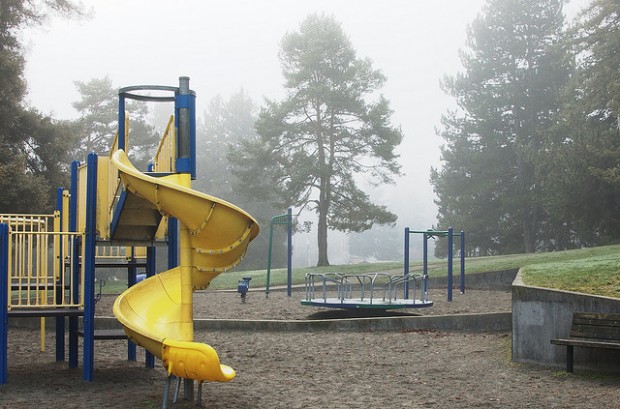Why Low-Income Kids Miss Out On Play

Old Mister Crow / Flickr
Remember playtime, when you would use your imagination to create a world of your own, with little structure or guidance? That kind of activity, called “free play,” helps boost childhood development and leads to better behavior in schools. But a new report by the American Academy of Pediatrics found low-income children in cities have limited opportunities to play.
It would seem that free play would be quite accessible, given that you don’t need expensive lessons or toys to participate. But there are a number of socioeconomic factors preventing low-income children from playing. Here are three:
Low-income kids are more likely to see recess cut from their school day.
Increasing the focus on academics and allotting less time for physical activity is a national trend. But the AAP report found that low-income school districts face greater cuts to recess and physical education because they are under pressure to reduce academic disparities. Nationwide, recess has been cut from one-third of schools with the highest poverty rates. Even after-school programs are shifting focus from creative and physical activities to homework help, often making them just an extension of the school day.
The D.C. Healthy Schools Act, passed in 2010, made physical education mandatory in D.C.’s public schools. Gym classes have to spend at least 50 percent of their time on actual physical activity. During the first year of the act, students had to spend at least 30 to 45 minutes a week in physical education classes. By the 2013-2014 school year, the time spent on physical education has to be 150 to 225 minutes a week.
There are fewer playgrounds in low-income, urban communities, or they may be underused because of a fear of violence
Cities have less green space than the suburbs, so playgrounds are one of the only places where children can roam around freely and play. Obviously, if there aren’t many around, you don’t have as many chances to play.
D.C. has 101 playgrounds, which averages out to 1.7 per every 10,000 residents. The city spends more money per resident parks and recreation than any other major city. But just having playgrounds in low-income communities isn’t enough; people are less likely to take advantage of such resources if they live in communities where there’s a fear of violence. Parents tend to restrict their kids’ outdoor playtime if they’re worried they could be victims of crime, according to a Kaiser Permanente and the Prevention Institute study.
Parents are busy insuring their families’ day-to-day survival.
If playgrounds and public spaces aren’t deemed safe for children, shouldn’t parents carve out time to accompany their kids so they do get adequate playtime?
“Although lower-income parents have the same desires for their children to succeed and reach their full potential as do parents with greater economic and social assets,” the report notes, “they must focus primarily on the family’s day-to-day survival.” Making sure your kids get outdoor playtime may not be your priority if you’re working multiple jobs or constantly stressed about bills, housing and food.
-
Shereen Alavian
-
http://twitter.com/carolinearmijo Caroline Armijo
-
Thomas Herman






